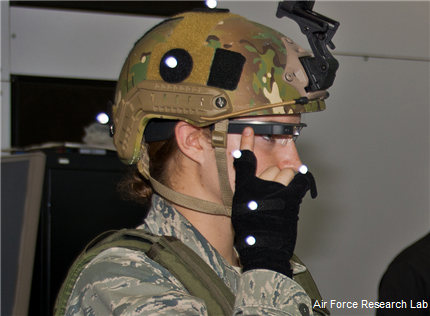Air Force's BATMAN team testing Google Glass
Researchers developing medical app for smartphones, tablets and Google Glass to be used by pararescue jumpers.

Google Glass could soon move from the realm of the techie hipster to that of the warfighter, as the Air Force begins testing the technology for pararescue jumpers and other operations.
Researchers of the Battlefield Air Targeting Man Aided kNowledge (BATMAN) team of the 711th Human Performance Wing have been testing the wearable computer displays. The wing is a part of the Human Effectiveness Directorate of the Air Force Research Lab and seeks to advance human performance in air, space and cyberspace.
Google Glass is a wearable computer equipped with an optical head-mounted display, touchpad and camera. The platform has a couple of existing Google applications, as well as third-party apps. The BATMAN team, which is conducting the research independently of Google, acquired the glasses through Google’s Explorer program, which requires that applicants are U.S. residents, at least 18 years old and pay a $1,500 fee.
The Explorer Program, which has only been open to businesses and select individuals, was opened to all U.S. residents April 15.
BATMAN is pilot-testing the technology primarily to assist pararescue jumpers, but may also be considering Google Glass for joint tactical controllers.
Pararescue jumpers are Air Force personnel recovery specialists with emergency medical training, and are expected to deploy in any available way to reach injured personnel. They are known to endure some of the toughest training in the military and are among the most highly trained emergency trauma specialists, according to the Air Force.
The research team is developing a medical app that can be used with Google Glass or a smartphone that would monitor vital signs of casualties. The app would allow the pararescue jumpers to determine which patients are most critical by providing vital signs through remote sensors, according to Information Week.
The team, which also consists of behavioral scientists and psychologists, are also examining whether the glasses will help enhance the ability to receive and send critical information.
"We recently did an experiment [with] Google Glass," said 2d Lt. Krystin Shanklin, a behavioral scientist with the BATMAN program, as reported by the Air Force. "We're trying to see how a [pararescue jumper] would use the device while multitasking with different distractions."
The researchers will be trying to mimic the chaotic nature of the battlefield by introducing distractions to users. Through the head-up display (HUD) feature of Google Glass, they will then be able to determine what information is relevant to them while performing a primary task such as driving or watching.
Google Glass isn’t the only HUD system that could fill growing military demand for the technology. Earlier this year, BAE tested its Q-Warrior helmet-mounted display, which is designed to increase situational awareness capabilities for foot soldiers.
NEXT STORY: Army plans its largest solar array to date